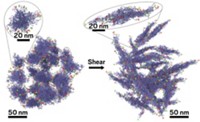Advertisement
Grab your lab coat. Let's get started
Welcome!
Welcome!
Create an account below to get 6 C&EN articles per month, receive newsletters and more - all free.
It seems this is your first time logging in online. Please enter the following information to continue.
As an ACS member you automatically get access to this site. All we need is few more details to create your reading experience.
Not you? Sign in with a different account.
Not you? Sign in with a different account.
ERROR 1
ERROR 1
ERROR 2
ERROR 2
ERROR 2
ERROR 2
ERROR 2
Password and Confirm password must match.
If you have an ACS member number, please enter it here so we can link this account to your membership. (optional)
ERROR 2
ACS values your privacy. By submitting your information, you are gaining access to C&EN and subscribing to our weekly newsletter. We use the information you provide to make your reading experience better, and we will never sell your data to third party members.
Biomaterials
Spider silk proteins condense into droplets to form silk
Scientists report that a phenomenon called liquid-liquid phase separation causes the silk proteins to solidify
by Alla Katsnelson, special to C&EN
November 4, 2020
| A version of this story appeared in
Volume 98, Issue 43

A spider rappelling down from a tree branch spins the hardy gossamer thread it hangs from as it descends. The proteins that make up the fiber, called spidroins, exist as a liquid in the spider’s silk glands but turn solid in an instant as the silk extrudes. “When it comes out of the spinner it’s this highly ordered hierarchical structure with nanofibrils,” says Ali D. Malay, a biochemist at RIKEN Center for Sustainable Resource Science. But how that conversion works, and how it happens so rapidly, is poorly understood.
In a new study, Malay and his colleagues show that a phenomenon called liquid-liquid phase separation (LLPS)—in which dissolved proteins condense into transient liquid droplets—drives this process in response to specific chemical cues, including phosphate and pH gradients (Sci. Adv. 2020, DOI: 10.1126/sciadv.abb6030).
The paper “is the first one to show that this mechanism is at play in spiker silk,” says Gregory P. Holland, a chemist at San Diego State University who was not involved in the work. By understanding the parameters that spiders use to drive silk assembly, researchers can mimic the process to improve how they create the strong, flexible material synthetically, he says.
Malay’s team engineered bacteria to make modified versions of spidroin proteins from the spider Trichonephila clavata. As they worked with the proteins, Malay and his colleagues noticed that sometimes, for example in response to heating, the solution would turn cloudy. At first they worried that their proteins might be unraveling and becoming dysfunctional, Malay says. “But looking under the microscope we saw these liquid droplets that were very dynamic,” he says. “They were fusing and coalescing.”
Malay surmised that they were observing LLPS. “We realized that this phenomenon was known, but not usually associated with spider silk,” he says. The researchers found that adding phosphate kicked LLPS into action, and that the proteins solidified and self-assembled into nanofibrils at a pH of 5.
By combining these cues, the researchers could orchestrate fibril formation from concentrated spidroin proteins extracted directly from spiders to produce 10 cm long silk fibers. When they stretched the fibers, the material formed a characteristic protein structure called a beta sheet, which accounts for spider silk’s strength. The researchers are now developing a method for making spider silk synthetically that is based on these chemical cues to more faithfully recreate the material, Malay says.
Holland says he has long suspected that LLPS was at play in spider-silk extrusion. “All the indicators were there in the literature,” he says, “but this was the first paper to actually put it all together.” The aggregation of spidroins through LLPS also has an intriguing parallel to the aggregation of proteins in the brains of people with neurodegenerative diseases such as Alzheimer disease, he says.





Join the conversation
Contact the reporter
Submit a Letter to the Editor for publication
Engage with us on Twitter